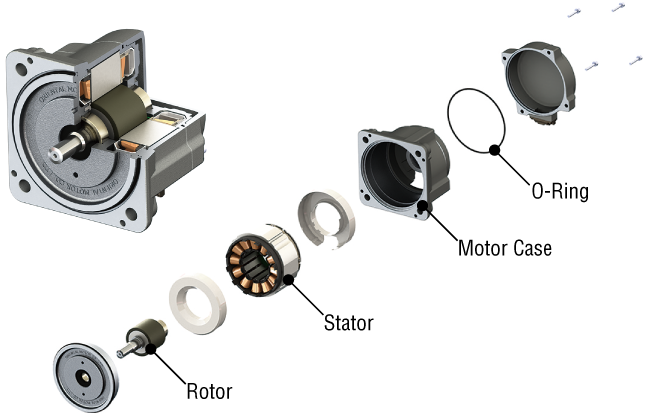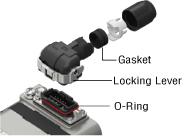What is the Motor IP?


-

What is it, Mr. Vex? Why are you staring at the catalog?
-

Actually, a customer asked me to introduce a speed control motor that meets IP65 or higher standards for conveyors, but I didn't know what IP65 was...
-

I see, IP is a standard that indicates the grade of dustproofing and waterproofing.
First, let me explain the IP code, which shows the IP degree of protection.The IP codes are in International Standards IEC 60529 and IEC 60034-5, which specify the test method as follows.

An "X" is used when one of the two protection classes is not specified (e.g. IPX5, IP4X).
Table 3: Meanings of IP Codes and Test Conditions
| IP Code | Protection against human contact with hazardous parts, protection against solid foreign objects entering the interior | |
|---|---|---|
| First Characteristic Digit | Protection Level | Test Condition |
| IP0X | None | None |
| IP1X | Protection against hand approach | Solid foreign objects with a diameter of 50 mm or more do not enter |
| IP2X | Protection against fingers approach | Solid foreign objects with a diameter of 12 mm or more do not enter |
| IP3X | Protection against tips of tools, etc. | Solid foreign objects with a diameter of 2.5 mm or more do not enter |
| IP4X | Protection against ingress of wires, etc. | Solid foreign objects with a diameter of 1.0 mm or more do not enter |
| IP5X | Protection against powdery dust | Powdery dust that may inhibit normal operation does not enter |
| IP6X | Completely dust-proof structure | Completely protected against dust ingress |
| IP Code | Degree of Protection Against Water Ingress | |
|---|---|---|
| Second Characteristic Digit | Protection Level | Test Condition |
| IPX0 | None | None |
| IPX1 | Protection against water drops falling vertically | Water droplets of 3-5mm/min from a height of 200mm,10 minutes |
| IPX2 | Protection against water drops from directions within a range of 15˚ relative vertically | Range of 15° below 200mm height, Water droplets of 3-5 mm/min, 10 minutes |
| IPX3 | Protection against raindrops from directions within a range of 60˚ relative vertically | Range of 60° below 200mm height, Water spray of 10L/min, 10 minutes |
| IPX4 | Protection against ingress of splashes from all directions | Sprayed water at a rate of 10 L/min from all directions at a distance of 300 to 500 mm, 10 minutes |
| IPX5 | Protection against water jet from all directions | Sprayed water jet of 30 kPa at a rate of 12.5 L/min from all directions at a distance of 3 m, 3 minutes |
| IPX6 | Protection from waves or powerful water jet | Sprayed water jet at a rate of 100 L/min and 100 kPa from all directions at a distance of 3 m, 3 minutes |
| IPX7 | Usable even if submerged in water under certain conditions | Immersion to a depth of 1 m, 30 minutes |
| IPX8 | Usable under water | Based on consultation between user and manufacturer |
You can watch a video of the waterproof test (IP4, IPX5, IPX6).
-

Thus, the IP code indicates the protection against "human bodily contact with dangerous parts," "entrance of solid foreign objects into the interior," and "ingress of water" in terms of ratings.
If you want to know the IP code of a motor or driver, refer to the catalog or website.
You can check the "degree of protection" in the general specifications of each product. -

The IP codes are so precisely defined.
When the customer said IP65, he meant a completely dustproof structure, and protection against water jets from all directions.
I wonder if that means it's an application where it is exposed to water... -

You need to be careful about that!
The protection against water ingress described in the IP code is a standard to prevent electric shock and fire in the event of water exposure.
You can determine if it's safe to turn off the power within a few minutes, but it's not designed for use in wet conditions, so you can't use just the IP code to determine if it's okay to use in a way that assumes it will be exposed to water!
- -

Really!
If it can't be determined by IP code, what should be the criteria for constant water exposure.... -

For applications where the product is constantly exposed to water, you can use whether it has undergone a water-washing resistant test* as a criterion or not.
This test is different from the short IP test for water ingress, as it tests the performance of the product in daily use where it is exposed to water.- *This is Oriental Motor's own test. Click here for details
In order to pass this test, brushless motors that claim to be waterproof have reinforced sealing structures at the motor and connector.
As an example, let's take a look at the IP66 BMU Series connector type and the BLE2 Series motor.
■Protective structure
-
- ①
- Motor Structure
A sealing insert (O-ring) is used for the mating part to prevent water from entering inside of the motor.
It can be used for applications that require washing in water.

-
- ②
- Connector Structure
The connector structure has a built-in gasket and O-ring for improved waterproofing.
It is IP67-compliant, including the connector part.

-

I see, there are many measures that need to be taken for dustproofing and waterproofing.
-

That's right.
Choose a motor that better suits to your customers' needs.
For applications exposed to water, don't forget to introduce the connection cable with IP66/IP67 specifications!
- September 2022 Updated with the latest information.